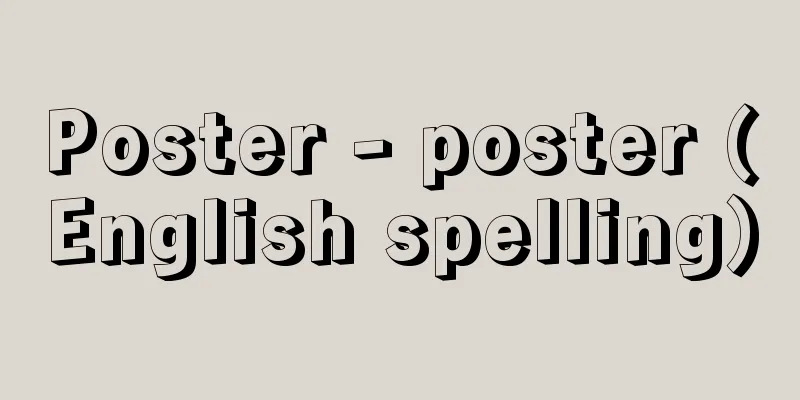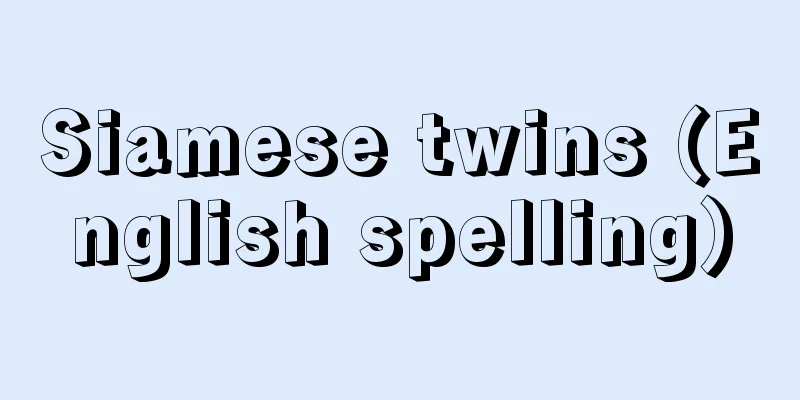Poster - poster (English spelling)

|
A piece of paper posted for the purpose of public relations and advertising, designed with pictures, photographs, text, etc. to achieve a desired purpose and appeal to the visual perception of the general public. In Japan, posting advertising leaflets has been practiced since the Edo period. Today, posters refer to relatively large printed materials that are posted in places where they are easily seen by the public, and have become an important field of graphic design. The name "poster" originally referred to sticking out a piece of paper on a pillar or wall (post), but nowadays the forms of poster display are extremely diverse. In Japan, poster boards on the streets are rarely seen, but in Europe there are poster boards and billboards for attaching posters, and temporary fences at construction sites are even used as display spaces with official permission. In countries such as America, where automobile transportation is well developed, it is common to create a single giant poster by pasting multiple large printed materials onto a board, such as "24-sheet posters." In Japan, posters are primarily used for transportation advertising, such as posters posted at train stations, posters hung inside trains (middle-hanging), and face-value posters. Posters come in a variety of sizes, including B-size (B-1, 728 x 1030 mm), B-2 (515 x 728 mm), B-3 (364 x 515 mm), and A-size (A-1, 594 x 841 mm). B-size is often used for posters hanging in train stations, while B-3 is generally used horizontally for posters hung inside train cars. In recent years, B-double size (twice the size of B-size) posters have also become common. Large posters made by pasting together pieces of paper have also become common in Japan. [Kunihiko Takei] History of postersIf we include handwritten flyers and the like, posters can be traced back in history to announcements made by ancient states to the people, but the trigger for the development of posters based on mass printing was the invention of lithography by Senefelder in 1798. Lithography subsequently underwent various improvements, achieving a wide variety of expressions using color, shorter printing times, printing on multiple sheets, and lower printing costs, providing fertile ground for poster design. Posters with a clear design consciousness first flourished in France around 1870, when Cheret, known as the "father of the poster," produced posters that could be called popular paintings using multicolor lithography, and their vibrant colors adorned the streets of Paris. Then, in the 1890s, Steinlen, Mucha, Lautrec, Bonnard, and others brilliantly developed their own unique expressive techniques. Lautrec in particular left behind many excellent works with bold compositions and outstanding lines. In the same period in England, Dudley Hardy (1867-1922), the Vegastaff Brothers (a joint pen name of William Nicholson (1872-1949) and James Pryde (1866-1941)), and Beardsley were also active. However, the expressive tendencies of these French and British poster artists still included a great deal of pictoriality and decorativeness. Entering the 20th century, with the maturation of industrial activity and the accompanying development of commercial activity, posters began to demonstrate a new power as a medium for advertising. Posters ceased to be pictures and began to aim for the rationality of modern design. The development of photography and the development of photomechanical (halftone dot) technology to incorporate the results of photography into printed matter provided new expressive power to the field of poster design. In the 1920s in France, designers such as Collin, Jean Carlu (1900-1997), and Cassandre were all active, but Cassandre is especially famous for his style that is full of dynamic movement and gives a clear impression. His work has had a significant influence on Japanese graphic designers. Furthermore, a succession of brilliant artists appeared, including Edward McKnight Kauffer (1891-1954), an American who won acclaim for his posters for the London Underground, Lissitzky, who based his work on constructivist methods, Moholy-Nagy and Herbert Bayer (1900-1985), who embodied the ideas of the Bauhaus, Jan Tschichold (1902-1974), who realized the true value of typography, and Herbert Matter (1907-1984), who made use of cutting-edge photographic images. During World War II, the British Abram Games (1914-1996) demonstrated his talent as a collaborator with the military. In the post-war period, the achievements of such notable names as Ben Shahn, Savignac, Max Bill, Erni, Giovanni Pintori (1912-1999), Josef Müller-Brockmann (1914-1996), Paul Rand (1914-1996), Herbert Leupin (1916-1999), Herb Lubalin (1918-1981), Saul Bass (1920-1996), Jan Lenica (1928- ), and Karl Gerstner (1930-2017) were notable, and fresh, healthy blood was infused into the history of poster design. In Japan, Hashiguchi Goyo, Wada Sanzo, Kitano Tsunetomi (1880-1947), Sugiura Hisui, and Kataoka Toshiro (1882-1945) were among those who supported the early days of poster design in the 1910s. Later, from the Taisho to Showa periods, Tada Hokuu (1889-1948), Yamana Ayao (1897-1980), Yoshida Kenkichi, Kono Takashi (1906-1999), and Okuyama Gihachiro (1907-1981) each developed their own unique expressive techniques. However, it was not until the 1950s, after World War II, that full-scale poster design began to take off in Japan. The "Graphics '55" exhibition held in 1955 (Showa 30) was a symbolic event of this era, and the exhibitors of this exhibition included Ito Kenji (1915-2001), Ohashi Tadashi (1916-1998), Kamekura Yusaku, Kono Takashi, Hayakawa Yoshio (1917-2009), Hara Hiromu, Yamashiro Ryuichi (1920-1997), and the American artist Rand, who was also invited to participate. In recent years, posters as a publicity and advertising medium have been evaluated as being in decline compared to television, newspaper and magazine advertising, etc. However, the freedom to freely set the expression format (color and size), number of posters to be displayed, display area, display period, etc., remains attractive even today. The rich color expression and the impact of a large area are characteristics unmatched by other advertising media, and by complementing advertising messages in other media and aiming for a synergistic effect, it is possible to deepen and expand an image. It is unlikely that posters will lose their position as the core of visual design in the future. [Kunihiko Takei] Poster depicting actress Sarah Bernhardt. Lithograph, 1896. Paris Musées . Mucha's "La Traviata" 1891 Lithograph ( Collection of the Art Institute of Chicago ) Toulouse-Lautrec's "Moulin Rouge, La..." Source: Shogakukan Encyclopedia Nipponica About Encyclopedia Nipponica Information | Legend |
|
広報および広告を目的として掲出される紙片で、所期の目的を達するため、絵や写真や文字などによってデザインし、多くの公衆の視知覚に訴えるもの。日本においては、宣伝用のビラを張り出すことが、すでに江戸時代から行われていた。今日ポスターといえば、公衆の目につきやすい場所に掲示される比較的大形の印刷物をさし、これはグラフィック・デザインの重要な分野となっている。 紙片を柱や壁に張り出すこと(post)がポスターの名称の始まりであるが、現代ではポスター掲出の様態は、きわめて多岐にわたっている。日本では街頭のポスター掲示板はほとんどみられないが、ヨーロッパにおいてはポスター掲示板やポスター貼付(ちょうふ)用広告塔が設定されているし、工事現場の仮塀が公許のもとに掲出スペースとして利用されてもいる。自動車交通の発達しているアメリカなどでは、「24シート・ポスター」のような、複数の大形印刷物を掲示板に張り合わせて巨大な1個のポスターをつくることも行われている。日本では、駅張りポスター、車内吊(づ)り(中(なか)吊り)ポスター、額面ポスターなどの交通広告の場が、ポスターのおもな活用の場となっている。 ポスターの寸法はさまざまであり、B全判(B列1番、728×1030ミリメートル)、B列2番(515×728ミリメートル)、B列3番(364×515ミリメートル)、A全判(A列1番、594×841ミリメートル)などがある。駅張りポスターはB全判が多用され、車内吊りポスターはB列3番の横位置使用を基本とする。近年ではB倍判(B全判の2倍)のものもみられる。また日本においても、紙片を張り合わせた大きなポスターが多く見受けられるようになってきた。 [武井邦彦] ポスターの歴史ビラのたぐいの手書きのものまで含めれば、歴史的には古代国家の民衆に対する告示にまでさかのぼることができるが、大量印刷を前提としたポスター発展の引き金となったのは、ゼーネフェルダーによる石版印刷術の発明(1798)である。石版印刷は、その後種々の改良を経て、色彩を駆使した多様な表現、印刷時間の短縮、多数枚葉の印刷、印刷費の低廉化などを成し遂げ、ポスター・デザインに対して肥沃(ひよく)な土壌を提供することとなった。 明確なデザイン意識を伴ったポスターが開花するのは1870年ころのフランスにおいてで、「ポスターの父」とよばれるシェレが登場し、石版多色刷りによる大衆絵画ともいうべきポスターを制作、躍動する色彩がパリの街頭を飾った。そして1890年代には、スタンラン、ミュシャ、ロートレック、ボナールらが、それぞれ独自の表現技術を華麗に展開。とくにロートレックは、大胆な構図と卓抜な描線とによって優れた作品を多数残している。同時代のイギリスではダドリー・ハーディDudley Hardy(1867―1922)、ベガスタッフ兄弟(ウィリアム・ニコルソンWilliam Nicholson(1872―1949)とジェームズ・プライドJames Pryde(1866–1941)の共作ペンネーム )、ビアズリーらが活躍した。しかし、これらフランス、イギリスのポスター作家の表現傾向は、絵画性あるいは装飾性をまだ多分に含むものであった。 20世紀に入ると、工業活動の成熟とそれに伴う商業活動の発展により、ポスターは宣伝広告のための媒体として新鮮な威力を発揮し始める。ポスターは絵画であることをやめ、近代のデザインとしての合理性を目ざすことになった。写真術の展開と、その成果を印刷物に援用するための写真製版(網点製版)技術の発展とが、ポスター・デザインの領域に新しい表現力を提供することになった。 1920年代のフランスでは、コラン、カルリュJean Carlu(1900―1997)、カッサンドルらが活躍するが、なかんずくカッサンドルは、力動感に満ち明快な印象を与える作風により、とくに名高い。彼の作品が日本のグラフィック・デザイナーに与えた影響は少なからぬものがある。さらに、アメリカ人であるがロンドン地下鉄のためのポスターによって喝采(かっさい)を博したコーファーEdward McKnight Kauffer(1891―1954)、構成主義の手法を踏まえたリシツキー、バウハウスの理念を体現したモホリ・ナギやハーバート・バイヤーHerbert Bayer(1900―1985)、タイポグラフィの真価を顕現したヤン・チヒョルトJan Tschichold(1902―1974)、先鋭な写真映像を駆使したハーバート・マターHerbert Matter(1907―1984)などの俊秀が、続々と現れた。第二次世界大戦中には、イギリスのエイブラム・ゲイムズAbram Games(1914―1996)が軍の協力者として才腕を発揮している。 戦後になると、ベン・シャーン、サビニャック、マックス・ビル、エルニ、ピントーリGiovanni Pintori(1912―1999)、ミューラー・ブロックマンJosef Müller-Brockmann(1914―1996)、ポール・ランドPaul Rand(1914―1996)、ロイピンHerbert Leupin(1916―1999)、ルバリンHerb Lubalin(1918―1981)、ソウル・バスSaul Bass(1920―1996)、ヤン・レニツァJan Lenica(1928―)、カール・ゲルストナーKarl Gerstner(1930―2017)らの活躍が顕著であり、新鮮で健康な血がポスター・デザインの歴史に注ぎ込まれた。 日本においては、1910年代の橋口五葉(ごよう)、和田三造、北野恒富(つねとみ)(1880―1947)、杉浦非水(ひすい)、片岡敏郎(としろう)(1882―1945)らが、ポスター・デザインの揺籃(ようらん)期を支えた。その後、大正から昭和にかけては、多田北烏(ほくう)(1889―1948)、山名文夫(あやお)(1897―1980)、吉田謙吉、河野鷹思(こうのたかし)(1906―1999)、奥山儀八郎(1907―1981)らが、それぞれ独自の表現技術を展開させている。しかし、日本において本格的なポスター・デザインが進発するのは、第二次世界大戦後の1950年代である。1955年(昭和30)開催の「グラフィック'55展」はこれを象徴するイベントで、同展の出品者は伊藤憲治(けんじ)(1915―2001)、大橋正(ただし)(1916―1998)、亀倉雄策(かめくらゆうさく)、河野鷹思、早川良雄(1917―2009)、原弘(ひろむ)、山城(やましろ)隆一(1920―1997)、これにアメリカのランドが招待作家として加わった。 近年、宣伝・広告媒体としてのポスターは、テレビや新聞雑誌広告などに比して、衰退ぎみであるとの評価もなされている。しかし、表現形式(色彩や大きさ)、掲出枚数、掲出地域、掲出期間などを任意に設定できるという自由さは、現代においても十分に魅力的である。豊麗な色彩表現と大面積の迫力は、他の広告媒体に例をみない特性であり、他媒体の広告メッセージと補完しあうことにより、さらには相乗効果を目ざすことにより、イメージを深化・拡大することが可能である。ポスターがビジュアル・デザインにおける中核としての地位を失うことは、今後ともないであろう。 [武井邦彦] 女優サラ・ベルナールを描いたポスター。1896年 リトグラフParisMusées"> ミュシャ『椿姫』 1891年 リトグラフシカゴ美術研究所所蔵"> ロートレック『ムーラン・ルージュ、ラ・… 出典 小学館 日本大百科全書(ニッポニカ)日本大百科全書(ニッポニカ)について 情報 | 凡例 |
<<: Postan - Postan (English spelling) Michael Moissey Postan
Recommend
dikastērion (English spelling) dikasterion
...This system seems to have disappeared after th...
Nejime [town] - Nejime
An old town in the western part of the Osumi Penin...
Viscum
…A semi-parasitic evergreen shrub of the family M...
Stable framework - Anti-Bone Group
...(5) Composite frame A frame that has both pin ...
potmum
… In addition, chrysanthemum breeding has been pr...
Domen - Domen
One of the tax collection methods in the Edo perio...
Kolombangara Island (English spelling)
A volcanic island in the southwest Pacific Ocean, ...
Car Ownership Department
〘Noun〙 In the pre-Taika period, the tribesmen in c...
Kaiseisho - Kaiseisho
A Western studies research and educational instit...
Bandwidth Compression - Taiikiashuku
Bandwidth compression : In the field of informatio...
Ou Main Line - Ou Main Line
The name of the track of East Japan Railway Compa...
Kamui Tunnel
...The name of the area originates from the Ainu ...
Boshubora (Boushuhora) - Boshubora (English spelling) Charonia sauliae
A large snail shell of the family Algalidae. The s...
Electrostatic generator
A device that generates high voltage by transporti...
Hibiya Riot Incident
A popular riot sparked by opposition to the peace...









